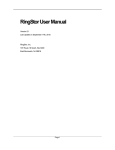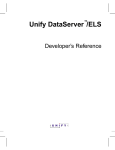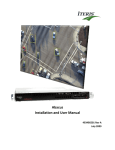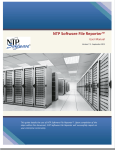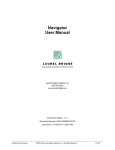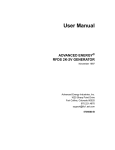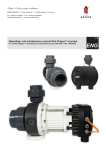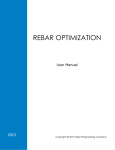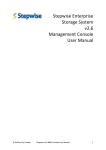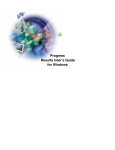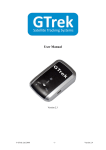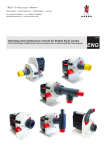Download RingStor User Manual - Welcome to RingStor, provider for cloud
Transcript
RingStor User Manual Version 2.1 th Last Update on October 17 , 2014 RingStor, Inc. 197 Route 18 South, Ste 3000 East Brunswick, NJ 08816 Page 1 Table of Contents 1 Overview ............................................................................................................................................... 5 1.1 RingStor Data Protection ................................................................................................................ 5 1.2 RingStor Cloud Backup Editions .................................................................................................... 5 1.3 Cloud Backup ................................................................................................................................. 6 1.4 DataAgent ....................................................................................................................................... 7 1.4.1 File Backup ................................................................................................................................. 7 1.4.2 Bare Metal Backup ...................................................................................................................... 8 1.4.3 SQL Database Backup ............................................................................................................... 8 1.4.4 MySQL Database Backup........................................................................................................... 8 1.4.5 Microsoft Exchange Backup ....................................................................................................... 8 1.4.6 Microsoft Exchange Mailbox Backup .......................................................................................... 8 2 1.5 Cloud End Point .............................................................................................................................. 8 1.6 Cloud Indexer ................................................................................................................................. 8 1.7 DataServer ...................................................................................................................................... 9 1.8 RingStor Explorer ........................................................................................................................... 9 Installation .......................................................................................................................................... 10 2.1 Installation Preparation ................................................................................................................. 10 2.2 Cloud End Point ............................................................................................................................ 10 2.2.1 System Requirement ................................................................................................................ 10 2.2.2 Install Cloud End Point .............................................................................................................. 11 2.3 Cloud Indexer ............................................................................................................................... 19 2.3.1 System Requirement ................................................................................................................ 19 2.3.2 Install Cloud Indexer ................................................................................................................. 19 2.4 DataServer .................................................................................................................................... 22 2.4.1 System Requirement ................................................................................................................ 22 2.4.2 Install DataServer...................................................................................................................... 22 2.5 DataAgent ..................................................................................................................................... 26 2.5.1 System Requirement ................................................................................................................ 26 2.5.2 Install DataAgent to RingStor Cloud ......................................................................................... 27 2.6 RingStor Explorer ......................................................................................................................... 29 2.6.1 System Requirement ................................................................................................................ 29 2.6.2 Install RingStor Explorer ........................................................................................................... 30 3 4 RingStor Explorer .............................................................................................................................. 31 3.1 Top Menu ...................................................................................................................................... 31 3.2 Explorer ........................................................................................................................................ 32 3.3 Content Tabs ................................................................................................................................ 32 Community ......................................................................................................................................... 40 4.1 Introduction ................................................................................................................................... 40 Page 2 4.2 Community Management ............................................................................................................. 41 4.3 Community Settings...................................................................................................................... 42 4.3.1 Mail ............................................................................................................................................ 42 4.3.2 Auto Update .............................................................................................................................. 42 5 Data Protection .................................................................................................................................. 44 5.1 Planning Data Protection .............................................................................................................. 44 5.1.1 Backup ...................................................................................................................................... 44 5.2 Agent ............................................................................................................................................ 45 5.2.1 File Backup ............................................................................................................................... 45 5.2.2 SQL Database Backup ............................................................................................................. 45 5.2.3 MySQL Database Backup......................................................................................................... 45 5.2.4 Exchange Backup ..................................................................................................................... 45 5.2.5 Exchange Mailbox Backup........................................................................................................ 45 5.2.6 Bare Metal Backup .................................................................................................................... 45 5.3 DataSet ......................................................................................................................................... 46 5.4 Backup .......................................................................................................................................... 56 5.4.1 Backup to Local Disk ................................................................................................................ 56 5.4.2 Backup to Local, Replicate to Cloud Storage ........................................................................... 57 5.4.3 Online Backup to RingStor Cloud ............................................................................................. 58 6 Data Recovery .................................................................................................................................... 60 6.1 Planning Data Recovery ............................................................................................................... 60 6.1.1 File Backup ............................................................................................................................... 60 6.1.2 SQL Database Backup ............................................................................................................. 60 6.1.3 MySQL Database Backup......................................................................................................... 60 6.1.4 Exchange Backup ..................................................................................................................... 60 6.1.5 Exchange Mailbox Backup........................................................................................................ 60 6.1.6 Bare Metal Backup .................................................................................................................... 60 6.2 Data Recovery .............................................................................................................................. 60 6.2.1 Restore from Local Backup....................................................................................................... 61 6.2.2 Restore from RingStor Cloud .................................................................................................... 61 6.2.3 Restore from Public Cloud ........................................................................................................ 62 7 8 9 Data Pruning ....................................................................................................................................... 64 7.1 Planning Data Pruning .................................................................................................................. 64 7.2 Data Retention .............................................................................................................................. 64 7.3 Data Pruning Task ........................................................................................................................ 64 Task Scheduling ................................................................................................................................ 65 8.1 Introduction ................................................................................................................................... 65 8.2 Schedule Backup Task ................................................................................................................. 65 8.3 Schedule Restore Task ................................................................................................................ 83 Data Storage ....................................................................................................................................... 96 Page 3 9.1 Introduction ................................................................................................................................... 96 9.2 MountPath Pool ............................................................................................................................ 96 9.3 MountPath .................................................................................................................................. 101 9.4 Storage Usage ............................................................................................................................ 107 10 User Management ............................................................................................................................ 109 10.1 Role............................................................................................................................................. 109 10.2 User ............................................................................................................................................ 109 11 Reports ............................................................................................................................................. 115 11.1 Introduction ................................................................................................................................. 115 11.2 Create New Report ..................................................................................................................... 115 11.3 Open Report ............................................................................................................................... 132 12 System Administration .................................................................................................................... 134 12.1 DataServer .................................................................................................................................. 134 12.1.1 Attach ...................................................................................................................................... 134 12.1.2 Detach ..................................................................................................................................... 134 12.2 DataAgent ................................................................................................................................... 134 12.2.1 Attach ...................................................................................................................................... 134 12.2.2 Detach ..................................................................................................................................... 135 12.3 Event Viewer ............................................................................................................................... 135 12.4 Task Manager ............................................................................................................................. 135 12.5 License Management ................................................................................................................. 135 12.5.1 Activation ................................................................................................................................. 136 12.6 Upgrades .................................................................................................................................... 136 13 Support ............................................................................................................................................. 138 Appendix A: Error Code ......................................................................................................................... 139 Page 4 1 Overview This user manual provides step by step instructions on how to install and manage RingStor enterprise data protection and recovery software suite, version 2.1. This document is also available on the web at http://www.ringstor.com. 1.1 RingStor Data Protection RingStor cloud backup software provides three different ways to backup the data: Online Backup Only, Local Backup Only and Local Backup with Replication. Online Backup Only: data is transmitted and saved to RingStor cloud storage. Local Backup Only: data is backed up to local storage only Local Backup + Replication: data is backed to local storage first, then replicated offsite to the remove storage, as shown in picture below. 1.2 RingStor Cloud Backup Editions RingStor suite comes with three editions designed for Professional Office, SMB and Enterprise. Following table Page 5 shows the difference among these three editions. 1.3 Cloud Backup RingStor suite comes with a cloud storage to provide data protection and recovery. A RingStor system consists of a cloud system, DataAgents and RingStor Explorer. The cloud consists of a Cloud End Point, Cloud Indexer, one or more DataServers and physical storage. The Cloud End Point is a set of lightweight software that serves as an access point for communication to cloud. The Cloud Indexer is a software service that provides indexing service to cloud. The DataServers and physical storage inside cloud system provide virtually unlimited capacity, highly scalable and on-demand available storage for applications. DataAgent is a software service running on computers where application data requires protection. In 2.1, DataAgent can backup file on Windows, Linux and Macintosh, Microsoft SQL, MySQL, Microsoft Exchange. RingStor Explorer is a graphic user interface for administrators to manage all components in RingStor. For more information about RingStor and its components, please visit on the web at http://www.ringstor.com. Page 6 An example of RingStor configuration is illustrated below: 1.4 DataAgent A DataAgent is a suite of software installed on a computer whose application data requires protection. Each application data is supported by an Agent that provides backup service. Agents supported in release 2.1 are File Backup, SQL Database Backup, MySQL Database Backup and Microsoft Exchange File Level Backup. Each DataAgent and its agents must be licensed to run in RingStor system. For additional DataAgent or agent license, please go to http://www.ringstor.com for details. 1.4.1 File Backup A File Backup agent can maintain multiple copies at different point of time for same file. File Backup can run in form of one or more full backup, with a number of incremental backups. Files protected under File Backup can be restored to a point of time selected by user. Page 7 1.4.2 Bare Metal Backup A Bare Metal Backup agent takes a snapshot of selected volumes and backup data to image files locally for quick disaster recovery. The image files can also be replicated to RingStor cloud for offsite storage and protection. 1.4.3 SQL Database Backup A SQL Database Backup agent can maintain multiple copies at different point of time for same database. SQL Database Backup can run in form of full backup, differential backup, transaction log backup and File Level backup. Full database backup must be performed first before any differential or transaction log backup. User can restore either a full backup or select a point of time for restore. File Level backup is used to provide file level copies of database data files and log files. 1.4.4 MySQL Database Backup A MySQL Database Backup agent can maintain multiple copies at different point of time for same database. MySQL Database Backup can run in form of File Level backup which backs up the exported file from MySQL database. 1.4.5 Microsoft Exchange Backup An Exchange Backup agent can maintain multiple copies at different point of time for same Exchange. Exchange Backup runs in form of File Level backup which backs data files, log files for the Exchange. 1.4.6 Microsoft Exchange Mailbox Backup An Exchange Mailbox Backup agent will backup individual messages in specified Exchange. Customer can browse and select message for restore. For Microsoft Exchange 2007 or newer version, Microsoft Exchange Server MAPI Client and Collaboration Data Objects client library must be installed prior to use RingStor Exchange Mailbox backup. The library can be downloaded from Microsoft web site at: http://www.microsoft.com/en-us/download/details.aspx?id=1004. 1.5 Cloud End Point A Cloud End Point is a lightweight software service to provide access point to DataAgents. The Cloud End Point can be deployed inside an enterprise network to provide LAN backup, this deployment is a private clou. The Cloud End Point can be also deployed with appropriate firewall settings to become a public cloud to DataAgents that use public internet for backup and restore. Each Cloud End Point must be licensed to run in RingStor system. For license info, please go to http://www.ringstor.com for details. 1.6 Cloud Indexer A Cloud Indexer is a software service to provide indexing service to cloud. The index for objects backed up inside cloud are maintained by Cloud Indexer. Page 8 1.7 DataServer A DataServer is a “cell brain” in RingStor cloud system to provide services in data protection, data recovery, etc. DataServer consists of a suite of software installed on a computer. In addition, DataServer provides a rich set of functionality on server side to browse and restore data etc. In Lite Edition, only one DataServer can be installed. In Standard and Enterprise Edition, multiple DataServers can be installed in RingStor system for load balancing. Each DataServer must be licensed to run in RingStor system. For additional DataServer license, please go to http://www.ringstor.com for details. 1.8 RingStor Explorer RingStor Explorer is a Windows based user interface that provides user the ability to manage every aspects of RingStor system. Page 9 2 Installation The installation of a complete RingStor system shall follow these steps: 1. The Cloud End Point must be installed first 2. Install Cloud Indexer 3. Install DataServer to the cloud 4. Install RingStor Explorer 5. Install DataAgent on computers where data need backup RingStor Explorer can be installed on every user’s computer to manage RingStor system. 2.1 Installation Preparation To install Standard and Enterprise Edition, following must be prepared before starting the installation: 1. A domain user account that will be used to run Cloud End Point, Cloud Indexer and DataServer services inside cloud. This domain user account must have full access to the paths specified in 2 and 3 below. 2. A network shared path where the domain user has full access. This network shared path will be used to store index. 3. One or more network shared path where data will be stored. Additional such path can be added after cloud installation is completed. For Lite Edition, Local System account can be used to install services. Locally connected hard drive can be used to store backed up data. 2.2 Cloud End Point Cloud End Point can be installed on following platforms: • Microsoft Windows XP/Vista/7/2003/2003 R2/2008/2008 R2/8/2012 • Recommended Memory: 3GB or more 2.2.1 System Requirement The following third party software must be installed prior to Cloud End Point installation: • Microsoft .NET Framework 3.5 is required. You may download .NET framework from microsoft.com at http://www.microsoft.com/enus/download/details.aspx?id=21 • For Cloud End Point installation, a local or remote SQL server must be available to create database repository. Supported database systems are: o Microsoft SQL server 2005, 2005 Express, SQL server 2008, 2008 Express, SQL server 2012, 2012 Express Page 10 TIP: For Microsoft SQL server system, TCP/IP must be enabled in Client Protocols as shown below: Figure 2.2.1 SQL Server Configuration Manager 2.2.2 Install Cloud End Point Run Installer Download proper version of the installation executable from http://www.ringstor.com. Run the downloaded executable on the computer to start Cloud End Point installation. Step 1 - Start Installation Page 11 Step 2 - License Agreement Page 12 Step 3 – Specify Installation Root Folder Step 4 – Menu and Shortcut Page 13 Step 5 - Cloud End Point hostname and port The host name will be pre-filled with current computer’s hostname or IP. If an IP is provided, the computer must be configured with static IP. The port is default to 9000, you may change the port. Cloud End Point service will listen on this port to provide services. IMPORTANT: Cloud End Point service must be added into firewall to allow both inbound and outbound connections. Click Next to continue. Step 6 – Set up Cloud Administrator Page 14 RingStor administrator’s username/password must be setup. RingStor Login Credentials Administrator Username – provide RingStor administrator’s username Administrator Password: - password for RingStor administrator Click Next to continue. Step 7 – Specify Database Repository Page 15 A database repository must be provided. RingStor cloud will stored system data in this repository. SQL Server – host name of the computer where SQL server is running TCP Port – TCP port for the SQL service (see tip on how to find TCP port) SQL Username – SQL server user account, this account must have permission to create database SQL Password – password for the user account above Database – name of the database TIP: How to find TCP port for Microsoft SQL service From SQL Server Configuration Manager (show in Figure 2.2.1), select SQL instance on the left, make sure TCP/IP is Enabled on the right, then double click to TCP/IP to bring up TCP/IP Proper window (Figure 2.2.2). Page 16 Figure 2.2.2: TCP/IP Property The IPAll section has TCP Dynamic Ports and TCP Port. Depending on the SQL server settings, only one should have a numeric value. Put this numeric value in TCP Port on this configuration step. Click Next to continue. Step 8 – Setup Cloud End Point Service Page 17 For Enterprise and Standard Edition, Cloud End Point service must run under a domain user which has full access to index repository. (Index repository is configured during CloudIndexer installation) Click Next to continue. For more information on how to grant Log On As Service permission for the user, open Local Security Policies window. You can access this window from Administrative Tools -> Local Security Policies. On this window, expand Local Policies -> Rights Assignment, find policy “Log On As Service” in right pane, open and verify or add user to this policy group. Following picture shows the Local Security Policy window: Page 18 Click Next to start and complete the installation process. 2.3 Cloud Indexer Cloud Indexer is a required component in Enterprise Edition. It can be installed on following platforms: • Microsoft Windows XP/Vista/7/2003/2003 R2/2008/2008 R2/8/2012 • Recommended Memory: 2GB or more 2.3.1 System Requirement The following third party software must be installed prior to Cloud End Point installation: • Microsoft .NET Framework 3.5 is required. You may download .NET framework from microsoft.com at http://www.microsoft.com/enus/download/details.aspx?id=21 2.3.2 Install Cloud Indexer Run Installer Download proper version of the installation executable from http://www.ringstor.com. Run the downloaded executable on the computer to start Cloud Indexer installation. Step 1 - Start Installation Page 19 Step 2 - License Agreement Step 3 – Specify Installation Root Folder Step 4 – Menu and Shortcut Step 5 – Provide Cloud info and credentials Step 6 - Set up index path for cloud. Page 20 For Standard and Enterprise Edition, the cloud index path must be a networked shared path so all components in cloud have access to. Click Next to continue. Step 7 – Setup Cloud Indexer Service Page 21 For Standard and Enterprise Edition, Cloud Indexer service must run under a domain user which has full access to index repository. Click Next to start and complete the installation process. 2.4 DataServer DataServer is the server that resides inside the cloud, registers itself to Cloud End Point upon start, and provides services to DataAgents for data protection, recovery and more. The DataServer can be installed on following platforms: • Microsoft Windows XP/Vista/7/2003/2003 R2/2008/2008 R2/8/2012 • Recommended Memory: 3GB or more 2.4.1 System Requirement The following third party software must be installed prior to DataServer installation: • Microsoft .NET Framework 3.5 is required. You may download .NET framework from microsoft.com at http://www.microsoft.com/enus/download/details.aspx?id=21 2.4.2 Install DataServer Run Installer Page 22 Download proper version of the installation executable from http://www.ringstor.com. Run the downloaded executable on the computer to start DataServer installation. Step 1 - Start Installation Step 2 - License Agreement Step 3 – Specify Installation Root Folder Step 4 – Menu and Shortcut Step 5 – DataServer hostname and port The host name will be pre-filled with current computer’s hostname or IP. If an IP is provided, the computer must be configured with static IP. The port is default to 9090, you may change the port. DataServer service will listen on this port to provide services. Click Next to continue. Page 23 Step 6 – Provide Cloud End Point info DataServer must connect to the existing Cloud End Point and register itself to become part of RingStor cloud, make sure Cloud End Point is online and provide Cloud End Point settings in this step. Cloud Hostname: the hostname or IP used when installing Cloud End Point Cloud Port: the port number that existing Cloud End Point service is listening on. Administrator Username: RingStor cloud administrator Administrator Password: RingStor cloud administrator’s password Click Next to continue. Step 7 – Create First MountPath Page 24 MountPath is a folder on hard drive with its full path provided above. In order for this DataServer to provide data protection, at least one MountPath must be accessible (read and write) by the DataServer. The MountPath may be of these two types based on the connection to DataServer: Directly Attached – the MountPath is hard wired to DataServer and only accessible by it. Network Shared – the MountPath is a shared path that is accessible via network The examples of Directly Attached MountPath may be c:\mydatarepository, e:\mydatarepository. The example of Network Shared MountPath may be \\mydataserver\mydatarepository For Standard and Enterprise Edition, MountPath must be a network shared path. Click Next to continue. Step 8 –Setup DataServer Service Page 25 For Enterprise and Standard Edition, DataServer service must run under a domain user which has full access to MountPath and Index. IMPORTANT NOTE: 1. The domain user account, or Local System, must have read and write permission to all MountPaths configured for this DataServer. If you use Network Shared MountPath, you must provide a valid domain user account here and grant this user full access to the Network Shared MountPath. 2. The domain user, if selected, must have Log on as service permission specified in Local Security Policy, please refer to Installation of Cloud End Point service for more information. Click Next to start and complete the installation process. 2.5 DataAgent DataAgent can be installed on following platforms: • Microsoft Windows XP/Vista/7/2003/2003 R2/2008/2008 R2/8/2012 • Linux, (Redhat, SUSE, Debian, OpenSUSE, etc) • Mac OS 2.5.1 System Requirement The following third party software must be installed prior to DataAgent installation: Page 26 • Linux: JRE 1.6 or higher. • Windows: Microsoft .NET Framework 3.5 is required. You may download .NET framework from microsoft.com at http://www.microsoft.com/en-us/download/details.aspx?id=21 2.5.2 Install DataAgent to RingStor Cloud Run Installer Download proper version of the installation executable from http://www.ringstor.com. Run the downloaded executable on the computer to start DataAgent installation. Step 1 – Start Installation Step 2 – License Agreement Step 3 – Specify Installation Root Folder Step 4 – Menu and Shortcut Step 5 – Register DataAgent to Existing RingStor cloud Page 27 RingStor Cloud End Point must be accessible by this DataAgent. RingStor user’s username/password must be provided to connect to RingStor cloud. Cloud End Point: Cloud Hostname – provide hostname or IP of an online Cloud End Point in existing RingStor cloud Cloud Port: - the port for the online Cloud End Point above RingStor Login Credentials: User – provide RingStor user’s username that has rights to install the DataAgent Password: - password for RingStor user Click Next to continue. Step 6 – Select Application Agents Available agents for this DataAgent are displayed and can be selected. The available agents are based on DataAgent’s platform and agents licensed to use on this platform. Please read Introduction section for description of each agent. Click Next to continue. Step 7 – Setup DataAgent Service Page 28 The domain user account above is NOT RingStor administrator account used in Step 4. Specify if DataAgent service will run under Local System account or a domain user account. For domain user account, please provide account, domain and password. IMPORTANT NOTE: 1. The domain user account, or Local System, must have read and write permission to all application data configured for protection on this DataAgent. 2. The domain user, if selected, must have Log on as service permission specified in Local Security Policy, please refer to Installation of Cloud End Point service for more information. Click Next to start and complete the installation process. 2.6 RingStor Explorer RingStor Explorer can be installed on following platform: • Microsoft Windows XP/Vista/7/2003/2003 R2/2008/2008 R2/8/2012 2.6.1 System Requirement The following third party software must be installed prior to RingStor Explorer installation: • Microsoft .NET Framework 3.5 is required. Page 29 You may download .NET framework from microsoft.com at http://www.microsoft.com/enus/download/details.aspx?id=21 2.6.2 Install RingStor Explorer Run Installer Run the downloaded executable on the computer to start RingStor Explorer installation. Step 1 – Start Installation Step 2 – License Agreement Step 3 – Specify Installation Root Folder Step 4 – Menu and Shortcut Step 5 – Finish Installation Click Next to start and complete the installation process. Page 30 3 RingStor Explorer RingStor Explorer is a graphic user interface (GUI) to access and manage RingStor system. In this interface, authenticated user can perform following functions: • View/Manage Communities • View/Manage DataServers, DataAgents and components installed on them • View/Manage Schedules • View/Manage Tasks • View/Manage Storage • View/Manage Users • View/Manage Reports • View/Manage License • View/Manage Updates Figure 3.1 RingStor Explorer The chapter will provide an overview of this GUI, the detailed functions are scattered in subsequent chapters. Figure 3.1 is an example screen shot. The GUI has three major areas, Top Menu, Explorers and Content Tabs. 3.1 Top Menu Page 31 Data Menu: Create New DataSet – create a new DataSet to start data protection Import Data from Local Disk – import backup data from local disk for a DataSet into cloud Task Menu: Schedule New Task – use to create a new schedule View Menu: DataAgent Explorer – open DataAgent Explorer on left side DataServer Explorer – open DataServer Explorer on left side Schedule Explorer – open Schedule Explorer on left side Storage Explorer – open Storage Explorer on left side User Explorer – open User Explorer on left side Storage Menu: Add New MountPath – add a new mount path to the cloud Add New MountPath Pool – add a new mount path pool to the cloud Storage Usage – check spaces for all MountPath and Backup Data Report Menu: Create New Report – create various reports Open Report – open an existing report System: Community – view and manage communities Cloud End Point – view system info on Cloud End Point License Info – show license installed, upgrade license Configuration – view and manage system wide configurations Help Menu: Documentation – links to online documents About RingStor – version info 3.2 Explorer DataAgent Explorer – view/manage DataAgents and agents DataServer Explorer – view/manage DataServers and storages Schedule Explorer – view/manage Schedules Storage Explorer – view/manage MountPath Pools and MountPaths User Explorer – view/manage users 3.3 Content Tabs Page 32 3.3.1 Event Viewer – view system events Figure 3.2 Event Viewer Tab All events are listed with time, severity, description and DataAgent/DataServer/Task if applicable. Double click one event to bring up the event detail window shown below: Page 33 Figure 3.3 Event Detail Window 3.3.2 Task List – view/manage running tasks Figure 3.4 Task List Tab Page 34 All running tasks and recently completed tasks are displayed in this tab. Right click each task to bring up the context menu for the task, Detail menu will provide more information about this task as show in the following: Figure 3.5 Task Detail Window 3.3.3 Storage tab – shown when Storage node is selected in DataServer Explorer Page 35 This tab lists all MountPath Pools that the DataServer is associated with. The DataServer has read and write access to all MountPaths in these MountPath Pools. 3.3.4 DataSet tab – shown when an agent is selected in DataServer Explorer Figure 3.6 DataSet Tab After selecting an agent in DataAgent Explorer on left, DataSet tab is activated to display all DataSets under this Page 36 agent for the DataAgent. 3.3.5 Schedules tab – view/manager schedules Figure 3.7 Schedules tab Schedules tab lists all schedules configured in RingStor. 3.3.6 MountPath tab – view/manage MountPath Page 37 Figure 3.8 MountPath tab Storage Explorer displays all configured MountPath Pools by the type, click each MountPath pool will activate this MountPath tab where all MountPaths under this pool are displayed. 3.3.7 Users tab – view/manager users Page 38 Figure 3.9 Users tab Users tab is activated to display all users under selected role in User Explorer. Page 39 4 Community 4.1 Introduction Community based data protection, recovery and management is added into RingStor 1.0 release. Community is a self-managed part of RingStor cloud system that the community only sees and manages its own components, DataAgent, DataServer, storage, users, configurations, etc. Each community possesses own resources and resources are not shared among the communities. The support of community based data protection and recovery within one RingStor cloud system present a great flexibility and manageability to enterprise data center that requires different set of business rules and separate resources for their customers, while the system can be easily managed by the data center via just one simple user interface. Page 40 4.2 Community Management Managing a community is simple via RingStor Explorer, just one form to fill out the required info to create a new community: Basic Info – provide name and optional description for the new community Administrator – Administrator for this community. The administrator can log into this community to manage all parts inside this community. Backup Data Size per DataAgent – Set maximum data that can be backed up per DataAgent. Backup Data Size per User – Set maximum data that can be backed up per User. Active Directory – Provide Windows domain information so windows users in this domain can be imported into this community. File Versions per User – Specify how many copies of a file will be retained for user in this community. Page 41 4.3 Community Settings 4.3.1 Mail Mail server can be set up to enable emailing reports, etc. 4.3.2 Auto Update RingStor DataAgent component can be updated either manually or automatically when the update becomes available. Page 42 Each community may have its own update URL where the update is checked and downloaded if available. Page 43 5 Data Protection 5.1 Planning Data Protection Before define application data to protect, a right data protection plan must be selected. In this release. 5.1.1 Backup Multiple copies of same application data may be preserved in RingStor storage system. • File Backup It has full and incremental. Full Backup: All application data are transmitted to RingStor, regardless if the data changes or not since last backup. Incremental Backup for File Only modified data since last successful backup are transmitted to RingStor. • SQL Database Backup It has File Level backup: File Level Backup: A file level full backup will take a snapshot of SQL database files and back them up. • MySQL Database Backup File Level backup is used to protect MySQL database. The database is exported from MySQL server via MySQL utility, the export file is backed up by RingStor. • Exchange Backup File Level backup is used to protect Microsoft Exchange. The data files, log files are backed up by RingStor. • Exchange Mailbox Backup Messages in selected Exchange mailbox are backed up. • Bare Metal Backup It has full and differential. Full Backup: The entire image of selected hard drives is transmitted to RingStor, regardless if the data changes or not since last backup. Differential Backup: Only modified data since last successful full backup are transmitted to RingStor. Page 44 Full backup or File Level Backup can be used to obtain a full copy of all application data. Application data at different point of time can be recovered. Pros: All data are protected up to the point of time of last successful full or incremental backup. Data at different point of time can be recovered. Cons: More storage might be required. Data retention can be complex. 5.2 Agent Agent is a RingStor configuration installed on DataAgent to support different data protection plan. Each agent must be licensed to be installed and used. To add more agents into the license, please go to http://www.ringstor.com for details. 5.2.1 File Backup File Backup is an agent that uses Backup to protect files and folder on a DataAgent. 5.2.2 SQL Database Backup SQL Database Backup is an agent that uses Backup to protect SQL database on a DataAgent. 5.2.3 MySQL Database Backup MySQL Database Backup is an agent that uses Backup to protect MySQL database on a DataAgent. 5.2.4 Exchange Backup Exchange Backup is an agent that uses Backup to protect Microsoft Exchange on a DataAgent. 5.2.5 Exchange Mailbox Backup Exchange Mailbox Backup is an agent that uses Backup to protect messages in Microsoft Exchange mailbox on a DataAgent. Please note, in order for RingStor to backup mailbox contents, make sure: a. For Microsoft Exchange 2007 or newer version, Microsoft Exchange Server MAPI Client and Collaboration Data Objects client library must be installed prior to use RingStor Exchange Mailbox backup. The library can be downloaded from Microsoft web site at: http://www.microsoft.com/enus/download/details.aspx?id=1004. b. DataAgent service account must have full permission to access Exchange mailboxes. 5.2.6 Bare Metal Backup Bare Metal Backup is an agent that uses Backup to protect a hard drive partition on a DataAgent. Page 45 5.3 DataSet DataSet is a collection of application data on DataAgent that require protection. DataSet’s protection scheme is supported by its associated Agent explained above. Creation of a DataSet is the first step to implement data protection plan in RingStor. You may start New DataSet Wizard from any of following places in RingStor Explorer. Main Menu -> Data -> Create New DataSet DataAgent Explorer -> DataAgent -> Right Click a DataAgent -> Create New DataSet DataAgent Explorer -> DataAgent -> Right Click an Agent -> Create New DataSet New DataSet Wizard This wizard walks through several steps to create a new DataSet. Step 1 – Introduction Page 46 Click Next to continue. Step 2 – Name the DataSet Page 47 Provide a friendly name for the DataSet. Provide optional description for the DataSet. Click Next to continue. Step 3 - Choose DataAgent/Agent Page 48 Select DataAgent, Agent for the DataSet. The available list of Agent is from installed agents on the selected DataAgent. Select backup mode for this DataSet: Online Backup, Local Backup or Local Backup + Replication. Online Backup: data is transmitted and saved to RingStor cloud storage. Local Backup: data is backed up to local storage only Local Backup + Replication: data is backed to local storage first, then replicated offsite to the remove storage, as shown in picture below. Click Next to continue. Step 4 – Depending on DataSet selected, specify contents for the DataSet File Backup DataSet Page 49 Step 4a.1 – Select Files/Folders For File Backup agents, select folders and/or files on DataAgent. Selected folders and/or files are DataSet’s contents. All data in contents will be protected and thus can be recovered. DataSet’s contents can also be modified after its creation. Step 4a.2 – Provide optional file type filter(s) Page 50 Optionally, filters can be added to skip files or folders in the DataSet: SQL Database Backup DataSet Step 4b.1 – Specify SQL Database Page 51 For SQL Database Backup agent, provide SQL server, username and password, database for protection. Click Get Databases button to list all databases and select one or more for DataSet. MySQL Database Backup DataSet Step 4c.1 – Specify MySQL Database Page 52 For MySQL Database Backup agent, provide MySQL server username and password, retrieve and select database for protection. Click Test Connection button to verify the inputs. Exchange Backup DataSet Step 4e.1 – Specify Exchange components Page 53 Exchange MailBox Backup DataSet Step 4f.1 – Specify Exchange mailboxes Bare Metal Backup DataSet Step 4g.1 – Select volumes Page 54 Final Step – Summary Page 55 Verify DataSet’s name and contents, click Back to make modifications, click Finish to create this DataSet. After creation, a pop up message will be displayed. 5.4 Backup RingStor provides various ways to backup the data, backup to local disk, backup online to RingStor cloud, backup to selected public cloud storage, ex. Amazon S3. 5.4.1 Backup to Local Disk Each DataSet has an option to Backup to Local Disk. To access this feature, right click a DataSet, select “Backup and Recover”. Page 56 Provide the folder on local disk of DataSet’s DataAgent. All local backups will be stored at specified location and available to restore. 5.4.2 Backup to Local, Replicate to Cloud Storage In addition to Backup to Local Disk, backup has an option to replicate the local backup to RingStor cloud, or other public cloud storage, ex. Amazon S3. To access this feature, right click a DataSet, select “Backup and Recover” as below: Page 57 5.4.3 Online Backup to RingStor Cloud Each DataSet has an option to backup to RingStor cloud. To access this feature, right click a DataSet, select “Backup and Recover”. Page 58 Page 59 6 Data Recovery 6.1 Planning Data Recovery Data protected by RingStor system can be recovered via Restore. Different agent allows different restore scheme. 6.1.1 File Backup Data protected under File Backup agent can be restored to different point of time: 6.1.2 o last full backup o previous full backup o specified point of time o specified version at file level SQL Database Backup Data protected under SQL Database Backup agent can be restored to different point of time: o last full backup o previous full backup o specified point of time Or to any successful File Level backup. 6.1.3 MySQL Database Backup Data protected under MySQL Database Backup agent can be restored to any successful File Level backup. 6.1.4 Exchange Backup Data protected under Exchange Backup agent can be restored to any successful File Level backup. 6.1.5 Exchange Mailbox Backup Data protected under Exchange Mailbox Backup agent can be browse and messages can be selected to restore. 6.1.6 Bare Metal Backup Data protected under Bare Metal Backup agent can be restored to different point of time: 6.2 o last full backup o previous full backup o specified point of time Data Recovery RingStor provides various ways to restore the data, restore from local backup, restore from RingStor cloud, Page 60 restore local backup from selected public cloud storage, ex. Amazon S3. 6.2.1 Restore from Local Backup If local backup was done and present for the DataSet, data can be restored from these local backups. To access this feature, right click a DataSet, select “Backup and Recover”. Select a local backup to restore, all data in selected local backup will be restored. 6.2.2 Restore from RingStor Cloud If the backup was done to RingStor cloud, online or replicated, data can be restored from RingStor cloud. Page 61 6.2.3 Restore from Public Cloud If backup was replicated to public cloud storage, ex. Amazon S3, data can be downloaded to local backup and restore from local backup can be used later to recover the data. Page 62 Page 63 7 Data Pruning 7.1 Planning Data Pruning Data pruning is to purge old and unused data from RingStor system. The following data are eligible for pruning provided their retention rules are met: 7.2 • Copy of DataSet content in RingStor system, provided that DataSet retention is met • RingStor events • RingStor task history • RingStor user activity history Data Retention The retention is based on number of file versions configured for the user or for the community. Please see Community section for instructions. 7.3 Data Pruning Task Pruning task can be scheduled to run to provide automatic data pruning. For more details on how to schedule a data pruning task, please refer to Task Scheduling section. Page 64 8 Task Scheduling 8.1 Introduction Task is the action to transmit data within RingStor system. All tasks are scheduled in RingStor system, kicked off by a DataServer when their schedules are due. RingStor supports various types of task: • Backup – to provide data protection for File Backup agent • Restore – to provide data recovery • Pruning – to purge old and unused data from RingStor Scheduling a task is a series of steps managed by Schedule New Task Wizard accessible from any of following places within RingStor Explorer. Main Menu -> Task -> Schedule New Task DataAgent Explorer -> DataAgent -> Right Click a DataAgent -> Schedule New Task DataAgent Explorer -> DataAgent -> Click an Agent -> Right Click a DataSet -> Schedule New Task DataAgent Explorer -> DataAgent -> Click an Agent -> Right Click a DataSet -> Browse DataServer Explorer -> DataServer -> Right Click a DataServer -> Schedule New Task 8.2 Schedule Backup Task Schedule New Task Wizard walks through several steps to create a new schedule. Step 1 – Introduction Step 2 – Name Schedule Page 65 Step 3 – Select Task Type Page 66 The available task type for selection depends on the DataSet. The picture above shows an example for a File Backup DataSet. Step 4 – Following are steps by steps instruction to schedule a backup task: Backup for File Backup DataSet Step 4.1 – Select DataAgent, Agent, DataSet and Backup Type, select Full or Incremental backup type as show below: Page 67 Backup for SQL Database Backup DataSet Step 4.2 – Select DataAgent, Agent, DataSet and Backup Type, select one of four backup types as shown below: Page 68 IMPORTANT NOTE: If select Full Backup, Differential Backup or Log Backup to protect SQL database, there must be no other database backup utility for selected database. File Level Backup – SQL database files (.mdf, etc) will be backed up. This option is only valid on Windows servers. Backup for MySQL Database Backup DataSet Step 4.3 - Select File Level Backup. File Level Backup will back up database data files, log files and configurations. Page 69 Backup for Exchange Backup DataSet Step 4.4 - Select Exchange Backup. Page 70 Backup for Exchange Mailbox Backup DataSet Step 4.4 - Select Exchange Mailbox Backup. Page 71 Backup for Bare Metal Backup DataSet Step 4.6 – Select DataAgent, Agent, DataSet and Backup Type, select one of four backup types as shown below: Page 72 Step 5 – Select Online Backup or Local Backup Page 73 Step 6 – Provide pre/post scripts if needed Page 74 Step 7 – Select Schedule Recurrence Type Page 75 Depending on recurrence type selected: One time Step 7.1 – Specify the date and time to run the task Page 76 Next step is Final Step - Summary Hourly Step 7.2 – Select Frequency, Start Time and End Time Page 77 Next step is Final Step - Summary Daily Step 7.3 – Select Frequency, Start Time and End Time Page 78 Next step is Final Step - Summary Weekly Step 7.4 – Select Frequency, Start Time and End Time Page 79 Next step is Final Step - Summary Monthly Step 7.5 – Select Frequency, Start Time and End Time Page 80 Next step is Final Step - Summary Yearly Step 7.6 – Select Frequency, Start Time and End Time Page 81 Next step is Final Step - Summary Final Step – Summary Page 82 Final step shows the summary of the schedule, click Back to make modifications, click Finish to create the schedule. A pop up message will be displayed after creation. 8.3 Schedule Restore Task Schedule New Task Wizard walks through several steps to create a new schedule. Step 1 – Introduction Step 2 – Name Schedule Page 83 Step 3 – Select Task Type The available task type for selection depends on the DataSet. The picture above shows an example for a File Backup DataSet. Step 4 – Following are steps by steps instruction to schedule a restore task Restore for File Backup DataSet Step 4a.1 – Select DataAgent, Agent and DataSet Step 4a.2 – Select Data To Restore and Restore Destination If DataSet is under File Backup agent, select destination as shown below: Page 84 If “Restore Selected Objects” is selected, next step is 4f.3 to select objects to restore. Step 4a.3 – Select Objects for Restore Page 85 Click the checkbox to select or remove objects for the restore. Restore for SQL Database Backup DataSet Step 4b.1 – For SQL Database Backup agent, select destination as shown below: Page 86 Step 4b.2 - Review or modify SQL database files names and locations Page 87 Click to change location and file name for original database files. IMPORTANT NOTE: The file to restore as must either not exist, or DataAgent can overwrite the files if they exist. Restore for MySQL Database Backup DataSet Step 4c.1 – For MySQL Database Backup agent, select destination as shown below: Page 88 Step 4c.2 - Review or modify SQL database files names and locations Page 89 Restore for Exchange Backup DataSet Step 4d.1 – For Exchange Backup agent, select destination as shown below Page 90 Restore for Bare Metal Backup DataSet Step 4e.1 – For Bare Metal Backup agent, select destination as shown below for image files Page 91 Step 5 – Specify Point of Time for Restore Page 92 Most Recent Copy: most recent copy for the DataSet or selected objects will be restored. From a Backup: data backed up in selected full backup will be all restored. Point of Time As Specified: data backed up on and before specified time will be restored. Step 6 – Provide pre/post scripts if needed Page 93 Step 7 – Select Schedule Recurrence Type Final Step – Summary Page 94 Final step shows the summary of the schedule, click Back to make modifications, click Finish to create the schedule. A pop up message will be displayed after creation. Page 95 9 Data Storage 9.1 Introduction Data transmitted to RingStor system are stored in MountPaths. MountPath is a folder resided on a magnetic disk, hard drive, USB drive, SAN drive, etc. Based on its connection to the DataServer, MountPath is split into two types: • Directly Attached – a local folder hard wired to a DataServer, for example, hard drive, USB drive • Network Shared – a network shared path accessible to all DataServers, for example a UNC path, a SAN drive IMPORTANT TIP: In order for DataServer to access a MountPath, the domain user account that DataServer service is runs with must have read/write access to the MountPath. Please see DataServer Installation for more details. MountPaths are grouped into a MountPath Pool. MountPath Pool is designed to control storage access for DataServers in RingStor system. Please refer to Storage Access Control section for details. 9.2 MountPath Pool MountPath Pool is a logic entity that contains a list of MountPaths. MountPath Pool can be of any of these three types: • Primary – MountPaths in the pool will be selected first by DataServer for storage • Secondary – MountPaths in the pool will be selected by DataServer for storage if no MountPaths in primary pool can be used. • Reserved – MountPaths in the pool will never be used. MountPaths in a MountPath Pool can be selected based on pool’s selection scheme: • Randomly – DataServer will select MountPath randomly for storage • Lowest Free Space First – DataServer will select MountPath with lowest free space first. • Highest Free Space First – DataServer will select MountPath with highest free space first. Creating a new MountPath Pool is a series of steps managed by Create New MountPath Pool Wizard accessible from any of following places within RingStor Explorer. Main Menu -> Storage -> Create New MountPath Pool Storage Explorer -> Right Click a MountPath Pool Type -> Create New MountPath Pool Page 96 Create New MountPath Pool Wizard Step 1 – Introduction Click Next to continue. Step 2 – Name the MountPath Pool Page 97 Provide a friendly name for the MountPath Pool, provide optional description. Click Next to continue. Step 3 – Select MountPath Pool Type Page 98 Select the type for this MountPath Pool. Click Next to continue. Step 4 – Specify MountPath Selection Scheme Page 99 Click Next to continue. Final Step - Summary Page 100 Final step shows the summary for the MountPath Pool. Click back to make modifications, click Finish to create the MountPath Pool. A pop up message will be displayed when creation completes. 9.3 MountPath Creating a new MountPath is a series of steps managed by Create New MountPath Wizard accessible from any of following places within RingStor Explorer. Main Menu -> Storage -> Create New MountPath Storage Explorer -> Right Click a MountPath Pool Type -> Create New MountPath Storage Explorer -> Right Click a MountPath Pool -> Create New MountPath Page 101 Create New MountPath Wizard Step 1 – Introduction Click Next to continue. Step 2 – Select MountPath Connection Type Page 102 Depending on connection type selected: Directly Attached Step 2a.1 – Specify DataServer and full path Page 103 Please note, the full path folder must be accessible by the DataServer selected. Click Next to continue to Step 3. Network Shared Step 2b.1 – Provide network shared path Page 104 Please note, the full path folder must be accessible by DataServers in RingStor system. Click Next to continue to Step 3. Step 3 – Select MountPath Pool Page 105 MountPath must belong to a MountPath Pool, select the MountPath Pool for this MountPath. Click Next to continue. Final Step - Summary Page 106 Final step shows the summary for the MountPath. Click Back to make modifications, click Finish to create the MountPath. A pop up message will be displayed after creation completes. 9.4 Storage Usage Storage Usage is a chart that display last 30 days of spaces for all Mount Paths and backup data. Administrator can view storage remaining and decide if and when more storage needs added to the cloud. Page 107 Average Storage Usage per Day: average growth of backup data Estimated Days Remaining: if backup data grows at average rate, how many days all MountPath will be filled. Please note, 5GB is default minimum reserve free space for each MountPath, backup will not be written to the Mount Path if its free space is less than minimum reserved space. Page 108 10 User Management 10.1 Role User must log into RingStor system with username and password to access the system via RingStor Explorer. The activity of user is tracked by RingStor and available in User Activity Report. Users are grouped by roles. Permission to RingStor system is determined by the role user belongs to. There are fixed roles supported in RingStor system. • Administrator – have permission to access all aspects of RingStor • DataAgent Operator –a user allowed to install and manage a DataAgent 10.2 User A user can belong to several roles. The permission of the user is aggregation of permission from all his/her roles. Creating a new user is a series of steps managed by Create New User Wizard accessible from any of following places within RingStor Explorer. User Explorer -> Right Click a Role -> Create New User Create New User Wizard Step 1 – Introduction Page 109 Create a new RingStor user. This user is only applicable to its community. Step 2. – Username and Password Page 110 Username must be unique in RingStor system. 2.2 Provide email and expiration time Page 111 Email is optional field. Step 3 – Assign roles Page 112 Step 5 – Summary Page 113 Review the user data, click Back to make modification, click Finish to create this user. Page 114 11 Reports 11.1 Introduction Reports can be generated from RingStor Explorer to provide summary for RingStor. Following reports are supported in RingStor: • Task Report – generate history info for tasks • Event Report – generate events for a given time frame, etc • Storage Report – generate summary info for all MountPaths • DataServer Report – generate summary info for all DataServers • DataAgent Report – generate summary info for all DataAgents • User Report – generate summary info for all users • User Activity Report – generate a list of activities for a user • Data Protection Report – generate report on DataSet’s protection status for a DataAgent • Task Detail Report – generate report on files backed up by a task Report can be generated in several formats, CSV, Html. Report can also be scheduled and emailed to specified users when ready. 11.2 Create New Report Creating a new report is a series of steps managed by Create New Report Wizard accessible from any of following places within RingStor Explorer. Top Menu -> Report -> Create New Report Create New Report Wizard Step 1 – Introduction Page 115 Step 2 – Name the report Page 116 Step 3 – Select report type Page 117 Step 4 – Set report criteria Task Report Page 118 Event Report Page 119 Storage Report Page 120 DataAgent Report Page 121 DataServer Report Page 122 User Report Page 123 User Activity Report Page 124 Data Protection Report Page 125 Task Detail Report Page 126 Step 5 – Select output format Page 127 Step 6 – Select delivery method Page 128 If On-demand is selected, click Next to go to final step. If Scheduled is selected, click Next to continue to set up the schedule. Step 7 – Select schedule reoccurrence Page 129 Depending on which recurrence is selected, use following step to provide schedule’s details. Step 8 – Select users that will receive the report Page 130 Step – Final Step Page 131 Click Back to make modification, click Finish to generate and open the report. 11.3 Open Report Generated reports are saved in cloud system and can be retrieved and opened for review. User can access open report menu from the following place: Main Menu -> Reports -> Open Report Following screen is the Open Report screen where user can specify the criteria to search reports. User can further select operation on selected reports. Page 132 Page 133 12 System Administration 12.1 DataServer 12.1.1 Attach Attach is an operation to add a DataServer to RingStor system and make it available for DataAgents for data protection. You may need attach in following scenarios: • Put a detached DataServer back to RingStor from RingStor Explorer • Add a newly installed DataServer to RingStor during its installation Attaching a DataServer “grows” RingStor system. More DataServers in RingStor, less load each DataServer takes, thus faster data can be transmitted to RingStor for protection. This feature of RingStor provides a real time, adaptive infrastructure. You may consider attaching more DataServers in the following scenarios: • More data on existing DataAgents are added for protection • New DataAgents are added • DataServers are overloaded, some tasks are running slow or halting due to lack of data streams 12.1.2 Detach Detach is an operation to remove a DataServer out of RingStor system and make it unavailable for DataAgents for data protection. You may need detach in following scenarios: • DataServer fails due to hardware, operating system • DataServer requires upgrade • Make DataServer unavailable for DataAgents to use temporarily Detach will automatically occur for a DataServer if any of following occurs: • License is invalid or expired Detaching a DataServer “shrinks” RingStor system. Less DataServers in RingStor, more loads other DataServers will take, thus slower data can be transmitted to RingStor for protection. 12.2 DataAgent 12.2.1 Attach Attach is an operation to add a DataAgent to RingStor system and make the data on it available for data protection. You may need attach DataAgent in following scenarios: • Put a detached DataAgent back to RingStor from RingStor Explorer • Add a newly installed DataAgent to RingStor during its installation Page 134 12.2.2 Detach Detach is an operation to remove a DataAgent out of RingStor system and make data on it unavailable for protection. You may need detach DataAgent in following scenarios: • DataAgent fails due to hardware, operating system • DataAgent requires upgrade • Temporarily stop all future tasks on DataAgent 12.3 Event Viewer System events can be viewed from Event Viewer tab in RingStor Explorer. Please see RingStor Explorer section for more details. 12.4 Task Manager Current tasks are displayed and can be managed in Task Manager from RingStor Explorer. Depending on the state of the task, you may manage task by Resume – resume a task that is either suspended or in wait state Suspend – suspend a task that is either running or in wait state Kill – kill a task Each task goes through different state. Following tables list the possible states: Scanning – task is scanning files and folders Running – task is transmitting data Assembling – task is assembling data blocks into application data Suspended – task is suspended by user, stop running Killed – task is killed by user Failed – task failed 12.5 License Management License must be valid for DataServer to start successfully. If license is invalid or expired, DataServer will detach Page 135 itself from RingStor, thus make it unavailable for all tasks. For current license info and usage, click Menu -> System -> License. Following is an example of such screen: Figure 13.1 License Sample 12.5.1 Activation To apply a full commercial license, or upgrade your license, follow the steps below to apply and activate the license: • Log into RingStor Explorer with administrator’s credentials (you created this during DataServer install) • From top menu, click System -> License, click Update License to upload license file. • Click Activate to activate the license. The license will be automatically prorogated to all DataServers in RingStor system. 12.6 Upgrades The RingStor upgrades are provided at http://www.ringstor.com/ when they become available. Page 136 You must register on ringstor.com web site, then log into your account to view and download upgrades. Please visit http://www.ringstor.com for details. Page 137 13 Support Support is available to all customers who have valid license. Standard support is provided for customers with free trial license. Please visit http://www.ringstor.com for details. Premium support packages are provided and can be purchased by contacting RingStor. Documentation can be downloaded from http://www.ringstor.com/ Page 138 Appendix A: Error Code Following table lists all error codes and corresponding error message. Error Code Message Notes 0 Operation succeeded 1 folder/file does not exist 2 folder/file cannot be read 3 data transfer is stopped due to request 108 MSSQL vss is in progress 109 data transfer is stopped due to request 110 fail to create task 111 fail to stop task 112 fail to resume task 113 fail to suspend task 114 fail to kill task 115 fail to update task 116 scan failed 117 task fail to start 118 task fails to read DataAgent's configuration task fails to load DataServers from DataAgent's 119 configuration 120 task fails to load DataSet from DataAgent's configuration task fails to load data contents for DataSet from 121 DataAgent's configuration 122 task fails to load task configuration 125 received an unknow task control command 127 DataAgent is detached 128 DataAgent is disabled 129 DataAgent is offline Page 139 130 DataAgent is uninstalled 131 fail to write data to specified destination folder/file 132 fail to access specified destination folder/file 133 task fails to read task configuration 135 to create task configuration 140 fail to access the MountPath 141 fail to establish connection for data transfer 144 task fails to connect to DataAgent for status update 145 unknown task type 146 task cannot be suspended in current state 153 task fails to connect to DataServer for data transfer 154 task started on wrong DataAgent 155 task is already created 156 fail to read index file 158 fails to access the chunk to read/write data 159 task has no running streams 199 file archiving task failed 200 file backup task failed 201 file restore task failed 206 file restore task failed 208 task fail to respond 209 file object already exists on DataAgent 210 fail to combine segments into one file object 211 chunk in use 213 data block already exists 214 fail to connect to Cloud End Point 215 data stream stopped running 216 task is not found Page 140 217 task is not in running state 218 fail to send task suspend message to DataAgent 219 fail to send task suspend message to DataServer 220 task platform is not supported 221 task is not in suspended state 222 fail to send task resume message to DataAgent 223 fail to send task resume message to DataServer 224 fail to send task kill message to DataAgent 225 fail to send task kill message to DataServer 226 db backup fail 227 restore fail 228 fail to compute hash for data block 229 fail to back up sql database 230 database backup type is missing 231 database files are missing 232 fail to restore database 233 data quota for DataAgent is exceeded 234 data quota for user is exceeded 235 task is not completed 236 task has no enought free space for its data 237 Exchange backup failed 238 Exchange restore failed 301 fail to send message 302 fail to receive message 303 fail to establish connection 381 unknown message received 402 failed to load DataServer's license file 403 DataServer's license has expired Page 141 maximum number of DataServers allowed by license has 404 been exceeded maximum number of DataAgents allowed by license has 405 been exceeded maximum number of Devices allowed by license has 406 been exceeded maximum number of Agents allowed by license has been 407 exceeded 408 agent type is not supported by the license 409 license key is invalid 410 license file is invalid 411 licensed time has not yet started 412 Full Text Indexer is not supported on this platform 413 cannot upgrade license to evaluation license number of Full Text Indexer allowed by license has been 414 exceeded 415 IP for DataServer is not allowed by the license OS for DataServer is not allowed by the license for this 416 DataServer # of processors for DataServer exceeds the allowed by 417 the license for this DataServer 418 user allowd to install has been exceeded 419 Cloud is not licensed, or license is not valid for this Cloud 420 License has been updated for this Cloud 501 fail to attach devices to DataServer 502 device is attached to DataServer 503 fail to detach devices from DataServer 504 device is detached from DataServer 510 device is not accessible 515 fail to create volume 518 no MountPath found Page 142 519 fail to create folder/file 521 fail to close segment for read/write 526 fail to access MountPath 529 MountPath is full 531 MountPath pool is not found 534 fail to retrieve child folders 535 fail to stamp MountPath 536 stamp for MountPath is not found 537 fail to verify MountPath 538 fail to mount MountPath 540 fail to access chunk 541 fail to create chunk 543 fail to seek segment in chunk 544 fail to delete chunk 600 fail to detach DataServer 601 fail to attach DataServer 602 DataServer is in detached mode, fail to start 603 master deamon fail to start 604 failed to mark DataServer online 605 failed to mark DataServer routings online 606 failed to start scheduler on DataServer 607 failed to start synchronization on DataServer 608 failed to start task monitor on DataServer 609 failed to start device monitor on DataServer 610 DataServer is detached by user 611 DataServer is attached by user 614 DataServer fails to connect to repository 618 user has no permission to detach DataServer Page 143 619 user has no permission to attach DataServer 620 user has no permission to update license on DataServer 621 DataServer is running in distributed mode 622 DataServer is running in shared mode 624 DataServer with same hostname already exists 625 DataServer fails to install 627 repository cannot be found 628 repository already exists 629 DataServer already installed 630 fail to save repository properties for DataServer 631 fail to create repository 633 fail to create DataServer service 634 fail to start DataServer service 635 fail to load DataServer property 636 fail to register DataServer to cloud 637 fail to unregister DataServer from cloud unable to connect to cloud, cloud service might be not 638 running 639 DataServer does not exist 640 DataServer configuration fail to connect to cloud 641 DataServer Pool is not provided 642 fail to access Active Directory 643 fail to authenticate in Active Directory 644 DataAgent and DataServer are not in same community 645 DataServer fail to start deamon 800 user is missing 801 user has no permission 802 user does not exist Page 144 900 fail to raise event 903 fail to subscribe alert 904 fail to unsubscribe alert 1000 VSS is supported 1001 VSS is not supported 1002 Wrong VSS command 1003 fail to create VSS copy 1004 fail to delete VSS copy 1500 cloud fail to load property 1501 cloud fail to start deamon 1502 no DataServer is online 1503 cloud fail to create registry file 1504 cloud fail to load registry file 1505 cloud fail to save registry file 1506 cloud fail to get hostname 1507 cloud fail to get port 1508 cloud fail to save property 1509 cloud fail to install service 1510 cloud fail to start service 1511 license file is not found 1512 fail to read license file 1513 cloud update already installed 1514 required update is not installed 1515 update on wrong platform 1516 cloud not found 1517 cloud update failed 1518 cloud update not installed 1519 cloud update is required by others Page 145 1520 newer update is detected 1521 only one DataServer can be installed for Limited edition 1522 cloud fail to access index path 2001 fail to log in 2002 fail to connect to end point 2003 DataServer is not specified 2004 fail to parse xml 2005 user did not log in 2006 no role is specified for the user 2007 no DataAgent is found 2008 fail to update DataAgent info 2009 fail to attach DataAgent 2010 fail to detach DataAgent 2011 fail to load DataAgent info 2012 fail to stop DataAgent 2013 no RingStor Cloud is configured 2014 fail to load DataAgent routing info 2015 fail to update DataAgent routing info 2016 no DataServer is found 2017 fail to load DataServer info 2018 fail to attach DataServer 2019 fail to detach DataServer 2020 fail to update DataServer info 2021 fail to load DataServer routing info 2022 fail to update DataServer routing info 2023 no DataAgent Pool is found 2024 fail to load DataAgent Pool info 2025 fail to update DataAgent Pool info Page 146 2026 fail to create DataAgent Pool 2027 fail to delete DataAgent Pool 2028 there are DataAgent(s) in the pool 2029 no DataServer Pool is found 2030 fail to load DataServer Pool info 2031 fail to create DataServer Pool 2032 fail to delete DataServer Pool 2033 fail to update DataServer Pool info 2034 fail to load DataSet 2035 no DataSet is found 2036 fail to create DataSet 2037 fail to create DataSet 2038 fail to create DataSet 2039 fail to create DataSet 2040 fail to create DataSet 2041 fail to update DataSet info 2042 fail to update DataSet info 2043 fail to update DataSet info 2044 fail to update DataSet info 2045 fail to update DataSet info 2046 no DataSet is specified 2047 no content is specified 2048 content is not found 2049 fail to delete DataSet 2050 fail to browse DataSet 2051 fail to browse DataSet 2052 fail to browse DataSet 2053 fail to browse DataSet Page 147 2054 no object(s) are specified 2056 no account is specified 2057 no account is found 2058 no account is found 2059 no store is specified 2060 no store is found 2061 no site is specified 2062 no site is found 2063 fail to update DataSet info 2064 fail to load events 2065 fail to check license 2066 fail to update license 2067 user does not exist 2068 role does not exist 2069 user does not have sufficient rights 2070 license key does not match 2071 fail to load MountPath info 2072 fail to create MountPath 2073 no MountPath is specified 2074 no MountPath is found 2075 fail to update MountPath info 2076 fail to delete MountPath 2077 fail to load MountPath Pool info 2078 no MountPath Pool is specified 2079 no MountPath Pool is found 2080 fail to update MountPath Pool info 2081 fail to create MountPath Pool 2082 cannot delete reserved MountPath Pool Page 148 2083 fail to delete MountPath Pool 2084 fail to load schedules 2085 fail to delete schedule 2086 no schedule is specified 2087 no schedule is found 2088 fail to update schedule 2089 fail to create schedule 2090 fail to get system status 2091 no event is specified 2092 fail to acknowledge system status 2093 fail to load tasks 2094 fail to load clouds 2095 fail to load roles 2096 no role is configured Page 149





















































































































































